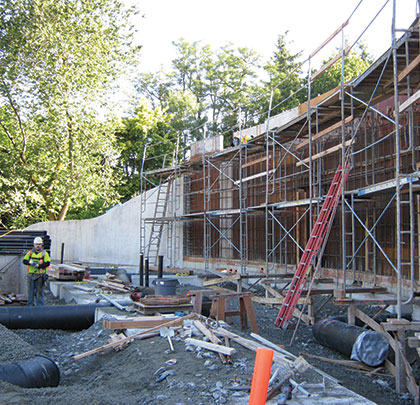Structural shotcrete is becoming a preferred method of construction for foundations, tanks, parking garages, and many other structures. Rather than pouring concrete into a moulded form, shotcrete is a method of spraying concrete from a hose under high pressure, allowing the structure to be built up in layers. The method is becoming increasingly popular with custom concrete structures, which would be difficult to shape using traditional formwork.
One such project was Vancouver’s award-winning VanDusen Botanical Gardens Visitors Center, which was redesigned and launched in 2011, making a strong impact regarding environmentally conscious building practices. The center not only maintains a scenic 55-acre botanical garden that attracts thousands of visitors annually, but there is also a strong educational focus regarding earth-friendly practices.
DESIGN PLANS
For the new visitor center, the designers wanted to showcase the center’s commitment to reducing the facility’s carbon footprint by creating a “living” building designed to Leadership in Energy and Environmental Design (LEED) Platinum certification standards.
Regulated by the Canada Green Building Council (CaGBC) LEED certification measures a building’s environmental impact. It is one of the most widely used project rating systems for new construction and major renovations.
The project team decided that structural shotcrete would be the best overall solution to construct the reinforced concrete walls given the building’s unique design, which curved and oscillated in the shape of an orchid. In addition to offering the required design flexibility, the shotcrete method also required half the formwork and equipment of regular cast-in-place, saving the team time and money.
The VanDusen project team enlisted Torrent Shotcrete Structures to create a reinforced shotcrete wall to reinforce a decorative rammed-earth wall. As the building needed to align with strict LEED Platinum requirements, the waterproofing system needed to conform to strict environmental specifications, as well as work as a long-term solution.
Waterproofing shotcrete can be challenging to those familiar with the process of cast-in-place concrete, even without strict green building requirements. Shotcrete has the potential to be more permeable and have larger, more frequent voids if an inexperienced contractor is used.
These voids are generally created when rebar is displaced during the period the shotcrete is still plastic. Additionally, any shotcrete placed by a less experienced nozzleman can contain insufficient consolidation or cold joints within the structure. Proper consolidation must be achieved to prevent imperfections, such as cracks, voids, and joints that could later cause waterproofing problems. An experienced contractor is able to place shotcrete with enough impact velocity to allow it to be consolidated, while also flowing around and encapsulating the reinforcement. This has the effect of producing a high-density, less permeable structure. The results are similar to vibrating cast-in-place concrete, but there is less risk of segregation.
EVALUATING SYSTEMS
Neither a sheet membrane system, nor a brush-on surface-applied waterproofing system was deemed appropriate for the VanDusen center’s unique design. Surface preparation and installation of a coating or membrane would have taken up valuable time. More importantly, the surface barrier would likely have been damaged during the installation of the rammed-earth portion of wall, which would have rendered the waterproofing useless. The use of VOCs in liquid-applied membranes, as well as the primers and joint adhesives for sheet membranes, also made these systems incompatible with the project’s environmental requirements.
Due to the limitations of surface applied waterproofing, consideration was given to integral waterproofing systems. Many structural shotcrete projects have turned to these systems, which include densifiers, water repellants, and crystalline/reactive systems. Integral systems are admixtures added at the batching plant and delivered premixed into the concrete. Instead of forming a barrier on the concrete’s surface, they turn the full depth of the concrete itself into a water barrier. They do not require additional surface preparation or labor to install, and once installed, they cannot be damaged by scratches and punctures.
Integral systems do have some special requirements. For example, they require a high level of consolidation to be fully effective, and also require a waterstop to be installed at the joints.
WATERPROOFING SOLUTION
After being presented with various waterproofing options, a crystalline system was specified for the project. The crystalline system comes in a powder form, and is added to the fresh concrete to reduce the material’s permeability and provide permanent waterproof protection. When added to the concrete mix, crystalline system’s chemicals grow millions of needle-like crystals throughout the concrete matrix, blocking the movement of water in all directions. These chemicals then remain dormant until cracks form, at which time they react with incoming water to grow additional crystals which “self-seal” the crack and maintain a watertight barrier.
Crystalline waterproofing is best suited to shotcrete because as an integral system it is not prone to damage or poor workmanship. The specified system can withstand extreme hydrostatic pressure and has a compatible crystalline waterstop that can withstand the rigorous shotcrete process. Additionally, it is a permanent solution, has an integrated repair system, and provides low cost and low risk.
The VanDusen Botanical Gardens Visitor Center is recognized throughout Canada and North America as one of the leading, pioneering green structures. Concerns regarding the concrete waterproofing selection went further than just the prevention of water penetration—it also had to fit strict criteria to fit in to the LEED Platinum parameters.
The building successfully achieved its goal of being self-sufficient and carbon neutral, along with obtaining LEED Platinum certification. ■
About the Author:
Jeff Bowman earned his bachelor’s degree in chemistry from the University of British Columbia in 2002 before joining Kryton International Inc., the same year. He has extensive experience in the development and use of various construction products for the repair and waterproofing of concrete, specializing in crystalline admixtures and repair materials. Jeff can be reached at jeff@kryton.com.
_________________________________________________________________________
Modern Contractor Solutions, October 2013
Did you enjoy this article?
Subscribe to the FREE Digital Edition of Modern Contractor Solutions magazine.

Waterproofing Green Architecture for West Coast Botanical Garden


